 Image search results - "wild" Image search results - "wild" |

Monkeys
|
|

Lake Hyoko (Lake Hyo), a man-made lake where thousands of swans and ducks migrate to during the winter months.
|
|
|

Duck feeding
|
|

Duck species in the lake and the number of birds so far.
|
|

In Oct. 2008, Lake Hyoko was added to the list of wetlands of international importance under the Ramsar Convention on Wetlands.
|
|

Thousands of ducks
|
|
|
|
|

Whooping swans mix with the ducks.
|
|
|

Swan
|
|
|
|
|
|

They all face the same direction. Group oriented.
|
|
|
|

Quack, quack. Actually the ducks were pretty quiet.
|
|

Ducks
|
|

Tourist info booth sells duck feed
|
|

At least 2 swans were in the pond along with koi fish.
|
|

Map of lake area
|
|

Pedestrian overpass with swan motif.
|
|

An egret stalking insects. It did not mind us photographers only meters away.
|
|

The only egret which never flew away when I approached.
|
|

Bird
|
|

Monkeys
|
|

Ducks
|
|

Ducks fly away on Lake Suwa.
|
|

Model of Amami Oshima's endemic Amami Kuro-usagi rabbit. Short ears and dark fur.
|
|

Okinawa World's Habu show was interesting, but not particularly thrilling. The viper is not like a trained monkey doing tricks for a treat each time. The snake doesn't understand such a concept.
|
|

Habu viper from Kumejima.
|
|

Meanwhile above, a black kite soars above looking for fish. The bird is a common site at Lake Biwa.
|
|

This crow was unafraid of humans. It was right in front of me and seemed to wait for food.
|
|

These heron birds make nests in Genkyu-en's trees.
|
|

A heron bringing back a branch to make a nest at Genkyuen Garden in Hikone, Shiga.
|
|

Hokkaido History Gallery includes wildlife exhibit.
|
|

Soon after we got to Nakajima, this black kite flew above. I tracked it with my camera. 「ピーヒョロロロロ…」
|
|

It then swooped down to the water and I started clicking away whether it would catch a fish or not. I was delighted to see it catch this large fish and captured the moment.
|
|

What a catch. It was my first time to capture a shot like this. I love these graceful and elegant birds which have a distinct cry.
|
|

Here's a close-up of the bird's claws grasping the gills of the fish. The bird sure knows where to grab a fish. The fish had no way to escape this grip.
|
|
|

Falconry demonstrations held at Hama-Rikyu Gardens on Jan. 3 in Tokyo.
|
|

Falconry demonstrations held at Hama-Rikyu Gardens on Jan. 3 in Tokyo.
|
|

Black kite going fishing トビ
|
|

Kawau cormorants. Shiga has over 40,000 of these birds, and 30,000 of them live on Chikubushima whose trees are being destroyed by the droppings and branches broken off to make bird nests.
|
|

Iriomote Wildlife Conservation Center is a great place to learn about the island's wildlife. There are some English captions too.
|
|

Inside Iriomote Wildlife Conservation Center. One floor full of panel exhibits and stuffed specimens.
|
|

About the Iriomote Wildlife Conservation Center.
|
|

Iriomote map shows where the Iriomote wildcat was sighted (orange tags with date and time) and roadkill locations (red tags). People need to drive carefully.If you see an injured or dead Iriomote wildcat, call 0980-85-5581.
|
|

About Iriomote's wildlife.
|
|
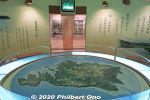
Map of Iriomote.
|
|

Iriomote with the main town of Ohara on the lower right.
|
|

The center's main exhibit is the stuffed Iriomote wildcats.
|
|

Iriomote is famous for the Iriomote wildcat (イリオモテ ヤマネコ). Endemic to Iriomote and critically endangered.
|
|

Only 100 or so left on the island. They are nocturnal and have stubby legs and a thick tail. Discovered relatively recently in 1965.
|
|

There's no zoo, etc., where we can see a live Iriomote cat. They only have stuffed Iriomote cats here at the Iriomote Wildlife Conservation Center.
|
|

In the past, they did have a live Iriomote cat here, found injured on the road and treated here.
|
|

Characteristics of the Iriomote wildcat.
|
|

Characteristics of the Iriomote wildcat.
|
|

Even though the Iriomote cat is all over Iriomote as a tourist symbol, we can't see any live ones.
|
|
|

Life cycle of Iriomote wildcat.
|
|

Skeleton of Iriomote wildcat.
|
|

Roadkill of Iriomote cats is a problem especially since they are nocturnal and Iriomote roads are dark. Residents are told to drive slowly at night.
|
|
|
|

Iriomote's birds.
|
|

Turtle on Iriomote.
|
|

Bats on Iriomote.
|
|

Bats on Iriomote.
|
|

About habu snakes (venomous).
|
|

Times for sunrise, sunset, moon rise/set, and high/low tide on Iriomote in Oct.
|
|

Stuffed toy Iriomote wildcat.
|
|

Sign welcoming you to the Kohoku Town Waterfowl Park along the northeastern shore of Lake Biwa, directly north of Nagahama. MAPThis is slightly north of Hayasaki Biotope.
|
|

Map of Kohoku-cho Waterfowl Park that includes a bird-watching center called Kohoku Wild Bird Center and the Biwako Waterfowl and Wetland Center.
|
|

Kohoku Wild Bird Center, admission 200 yen. This center was established by Shiga Prefecture in Nov. 1988 and it is operated by Kohoku town. 湖北野鳥センター
|
|

Inside Kohoku Wild Bird Center. It has large picture windows facing Lake Biwa and high-powered binoculars enabling you to clearly see the waterfowl. 湖北野鳥センター
|
|

View from the Kohoku Wild Bird Center.
|
|

The birds rest on a small island close to the shore.
|
|

On this day in Feb., I saw ducks and gray heron (ao-sagi).
|
|

Ducks
|
|

Tundra swans from Siberia at Lake Biwa.
|
|
|

Bean geese at Lake Biwa.
|
|
|

Amateur photographers, birdwatchers, and sightseers along the shore during winter is a common sight.
|
|

The Kohoku Wild Bird Center is well equipped for bird-watching and also features exhibits of stuffed birds.
|
|

Bulletin board indicating the bird species observed that day and where they were seen in the area. The center keeps track of bird locations in Lake Biwa, Hayasaki Naiko Biotope, and Mt. Yamamoto-yama.
|
|

Display of various bird nests.
|
|

On the opposite side of the center is Mt. Yamamoto-yama. On this day in Feb., we saw the Steller's sea eagle perched on a tree on this mountain.
|
|

Actual-size cutout of Steller's sea eagle. The center has two telescopes aimed at the bird for a clear view. It is a very large bird with a wingspan of over 2 meters. You need a very large telephoto lens to photograph the bird on the mountain.オオワシ
|
|

Explanation of Steller's sea eagle and its movement in the area.
|
|

Migratory patterns in the Kohoku area.
|
|

Connected via a passageway to the Kohoku Wildbird Center is the Biwako Waterfowl and Wetland Center set up by the Ministry of the Environment in 1997. It is also operated by Kohoku town.
|
|

Viewing room in the Biwako Waterfowl and Wetland Center.
|
|

Autographs of various prominent people who visited the Kohoku Wild Bird Center.
|
|

Heron stalking fish in the pond at Kameido Tenjin Shrine.
|
|

White heron (shirasagi) hanging out on the pond.
|
|

It soon snagged a baby carp from the pond. Poor innocent fish. It must be traumatic to be caught in a bird's beak and be swallowed whole.
|
|

Kameido Tenjin Shrine also has many turtles in the pond. All these years, I thought they were cute. But I recently found out that these turtles are actually invasive species called red-eared slider or red-eared terrapin.Popular as pets when they are small.
|
|

A black kite is perched in a cherry tree.
|
|

Ducks in winter. Mishima Pond is one destination in Shiga for migratory birds.
|
|
|

Mishima Pond, Maibara, Shiga.
|
|

Mishima Pond, Maibara, Shiga.
|
|
|

The ducks welcome feeding by humans. Cat food works well.
|
|
|
|
|
|

All these ducks love me.
|
|
|
|
|

Baby monkey. From generation to generation, these monkeys develop and pass down their habit of bathing in this hot spring.
|
|

Snow monkeys taking a bath and showing relaxed faces.
|
|

It's not unusual to see wild monkeys in Japan. So to the Japanese, these monkeys are not exotic nor unusual, even if they are bathing in an onsen.
|
|

My favorite shot. I'm not sure if he's exhibiting a derogatory gesture to us humans. The calluses on the buttocks serve as a cushion for sitting. It seems that they don't have the cushy/fatty buttocks that we do, so they need to grow calluses instead.
|
|

Display of stuffed toki or crested ibis, an endangered species. Official bird of Niigata and raised on Sado island.
|
|
|

Sea gull on the lake.
|
|

Swans along Lake Toya, Sobetsu, Hokkaido
|
|
|

White heron and cherry blossoms.
|
|

Grey heron and cherry blossoms.
|
|

Heron finds a snack.
|
|

Grey heron
|
|

Lake Toya and swan, Hokkaido
|
|

At Kushiro City Red-Crowned Crane Natural Park, baby red-crowned crane in mid-June 2022. That's the mother on the left.
|
|

Red-crowned crane, Kushiro City Red-Crowned Crane Natural Park, Hokkaido.
|
|

Red-crowned crane, Kushiro City Red-Crowned Crane Natural Park (Kushiro Japanese Crane Reserve).
|
|
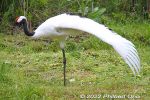
Red-crowned crane, Kushiro City Red-Crowned Crane Natural Park (Kushiro Japanese Crane Reserve).
|
|

Red-crowned crane, Kushiro City Red-Crowned Crane Natural Park (Kushiro Japanese Crane Reserve).
|
|

The Oriental white stork is a big, beautiful bird often mistaken as the Japanese crane. Wingspan is 2 meters.
|
|

Toyooka was where the last living Oriental white stork in Japan died in 1986. Pesticides in rice paddies (where they feed) and other environmental problems caused their demise.
|
|
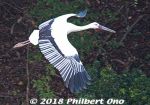
I didn't expect to see the storks flying around, so I was thrilled when a few of them flew overhead while I was in the park. They flew in during feeding time.
|
|
|
|
|
|

White stork landing in the paddy during feeding time.
|
|

Feeding time for the storks also attracts unwanted birds like black kites. They swoop in and steal a fish, then don't come back.
|
|

Grey herons also drop by, but they are always fighting each other.
|
|

Oriental white stork eating a fish.
|
|
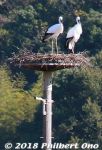
Two Oriental white storks on a nesting platform. Each nesting platform has a video camera monitoring it 24/7 especially during the egg-laying and hatching season in spring.The park is likely crowded during this time until the babies leave the nest in June/July.
|
|

Some wild monkeys on the mountain road.
|
|

Wild monkeys on the mountain road in Yakushima. Waiting to get food tossed by tourists. (None from us.)
|
|
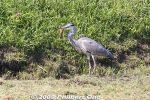
Heron with a frog at Lake Yogo, Nagahama, Shiga.
|
|

Ducks on ice
|
|

Saw me and they flew away
|
|
|
|
|
|
|